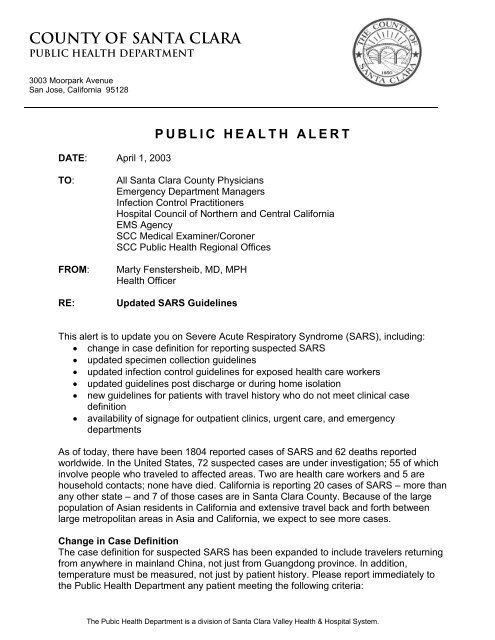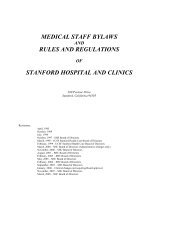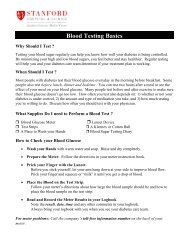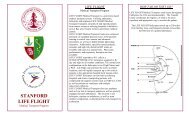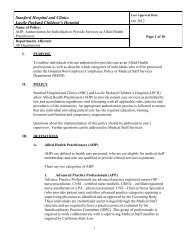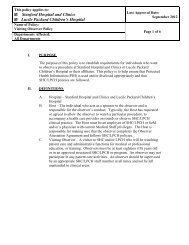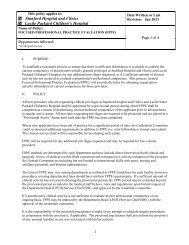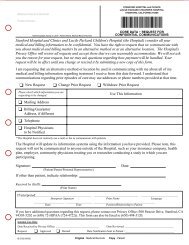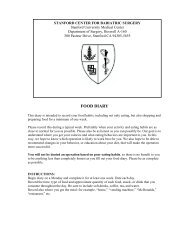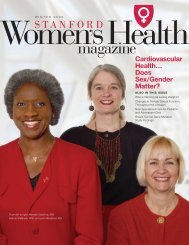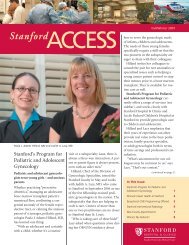COUNTY OF SANTA CLARA - Stanford Hospital & Clinics
COUNTY OF SANTA CLARA - Stanford Hospital & Clinics
COUNTY OF SANTA CLARA - Stanford Hospital & Clinics
You also want an ePaper? Increase the reach of your titles
YUMPU automatically turns print PDFs into web optimized ePapers that Google loves.
County of Santa Clara<br />
Public Health Department<br />
3003 Moorpark Avenue<br />
San Jose, California 95128<br />
DATE: April 1, 2003<br />
PUBLIC HEALTH ALERT<br />
TO: All Santa Clara County Physicians<br />
Emergency Department Managers<br />
Infection Control Practitioners<br />
<strong>Hospital</strong> Council of Northern and Central California<br />
EMS Agency<br />
SCC Medical Examiner/Coroner<br />
SCC Public Health Regional Offices<br />
FROM: Marty Fenstersheib, MD, MPH<br />
Health Officer<br />
RE: Updated SARS Guidelines<br />
This alert is to update you on Severe Acute Respiratory Syndrome (SARS), including:<br />
change in case definition for reporting suspected SARS<br />
updated specimen collection guidelines<br />
updated infection control guidelines for exposed health care workers<br />
updated guidelines post discharge or during home isolation<br />
new guidelines for patients with travel history who do not meet clinical case<br />
definition<br />
availability of signage for outpatient clinics, urgent care, and emergency<br />
departments<br />
As of today, there have been 1804 reported cases of SARS and 62 deaths reported<br />
worldwide. In the United States, 72 suspected cases are under investigation; 55 of which<br />
involve people who traveled to affected areas. Two are health care workers and 5 are<br />
household contacts; none have died. California is reporting 20 cases of SARS – more than<br />
any other state – and 7 of those cases are in Santa Clara County. Because of the large<br />
population of Asian residents in California and extensive travel back and forth between<br />
large metropolitan areas in Asia and California, we expect to see more cases.<br />
Change in Case Definition<br />
The case definition for suspected SARS has been expanded to include travelers returning<br />
from anywhere in mainland China, not just from Guangdong province. In addition,<br />
temperature must be measured, not just by patient history. Please report immediately to<br />
the Public Health Department any patient meeting the following criteria:<br />
The Pubic Health Department is a division of Santa Clara Valley Health & <strong>Hospital</strong> System.
Respiratory illness of unknown etiology with onset since February 1, 2003, and the<br />
following criteria:<br />
Measured temperature >100.4 °F (>38° C)<br />
AND<br />
One or more clinical findings of respiratory illness (e.g. cough, shortness of breath,<br />
difficulty breathing, hypoxia, or radiographic findings of either pneumonia or acute<br />
respiratory distress syndrome)<br />
AND<br />
Travel within 10 days of onset of symptoms to an area with suspected or<br />
documented community transmission of SARS (Peoples' Republic of China,<br />
including Hong Kong Special Administrative Region; Hanoi, Vietnam; and<br />
Singapore)<br />
OR<br />
Close contact (e.g. having cared for, having lived with, or having had direct<br />
contact with respiratory secretions and /or body fluids of a patient known to be a<br />
suspect SARS case) within 10 days of onset of symptoms with either a person<br />
with a respiratory illness and travel to a SARS area or a person under<br />
investigation or suspected of having SARS.<br />
During business hours, report suspected cases to Disease Prevention and Control at<br />
408-885-4214; after hours and on weekends, report to the Public Health Officer on call<br />
by calling County Communications at 408-299-2501.<br />
Laboratory Specimen Collection<br />
The Centers for Disease Control and Prevention (CDC) and the state Department of<br />
Health Services (DHS) now recommend that we collect urine and stool samples as well as<br />
NP swabs and paired sera. This is because in some of the initial laboratory investigations,<br />
a coronavirus was identified in kidney tissue. We recommend that the evaluation of<br />
patients presenting with suspected SARS first include a diagnostic work up for other<br />
potential etiologies of febrile respiratory illness:<br />
CBC with differential (SARS patients will frequently show leukopenia and<br />
thrombocytopenia)<br />
CXR<br />
Routine Sputum gram-stain and culture<br />
Blood cultures<br />
If available at the clinical lab:<br />
Nasopharyngeal swabs for viral Direct Flourescent Antibody (DFA) and/or<br />
culture, specifically influenza A and B, parainfluenza, and respiratory synctial<br />
virus<br />
Sputum for Legionella culture and Direct Flourescent Antibody (DFA)), and urine<br />
for Legionella pneumophila serogroup 1 antigen (Ag)<br />
NOTE: all specimens collected from suspected SARS patients should be labeled<br />
“suspected SARS patient”; the clinical laboratory should be notified so that they can<br />
institute BSL-3 practices when processing these specimens.<br />
2
Specimens to be collected for transport to the Santa Clara County Public Health<br />
Laboratory, who will then process and forward to the CDC laboratories:<br />
At least two nasopharyngeal swabs (NP) in Viral Transport Medium. NOTE: use<br />
only sterile dacron or rayon swabs with plastic shafts. Do NOT use calcium alginate<br />
swabs or swabs with wooden sticks, as they may contain substances that inactivate<br />
some viruses and inhibit PCR testing.<br />
Endotracheal Tube aspirate (if intubated)<br />
Urine - 50 cc of first void morning urine, collected during the acute phase of illness.<br />
The county public health laboratory will centrifuge the urine and re-suspend the<br />
sediment.<br />
Stool – collect 10-50 cc in a stool cup or urine container, cap securely.<br />
Serum – 4-6 ml in red or tiger top tube. Collect within 7 days of symptom onset.<br />
Whole blood – 8 ml whole blood in CPT-citrate (Becton Dickinson) tube.<br />
If the clinical laboratory cannot perform viral DFA and culture, or Legionella studies,<br />
these specimens can also be sent to the Santa Clara County Public Health Lab –<br />
we do not recommend sending these specimens to outside reference laboratories to<br />
minimize the chance of lab worker exposure.<br />
Updated Infection Control Guidelines for exposed healthcare workers<br />
Several healthcare workers have been reported to have developed Severe Acute<br />
Respiratory Syndrome (SARS) after caring for patients with SARS. Although the infectivity<br />
and etiology of SARS are currently unknown, transmission to healthcare workers appears<br />
to have occurred after close contact with symptomatic individuals (e.g., persons with fever<br />
or respiratory symptoms) before recommended infection control precautions for SARS<br />
were implemented (i.e., unprotected exposures). Personal protective equipment<br />
appropriate for standard, contact, and airborne precautions (e.g., hand hygiene, gown,<br />
gloves, and N95 respirator) in addition to eye protection, have been recommended for<br />
healthcare workers to prevent transmission of SARS in healthcare settings (see<br />
http://www.cdc.gov/ncidod/sars/ic.htm). More general information on infection control in<br />
healthcare workers is available at http://www.cdc.gov/ncidod/hip/GUIDE/infectcont98.htm.<br />
CDC, in collaboration with state and local health departments, is developing a systematic<br />
approach for surveillance of SARS exposures and infection in healthcare workers for use<br />
by healthcare facilities. Additional information on surveillance materials will be forthcoming.<br />
Given the currently available information on the epidemiology of SARS in the United<br />
States, the following outlines interim guidance for the management of exposures to SARS<br />
in a healthcare facility.<br />
3<br />
1. Exclusion from duty is recommended for a healthcare worker if fever or respiratory<br />
symptoms develop during the 10 days following an unprotected exposure to a<br />
SARS patient. Exclusion from duty should be continued for 10 days after the<br />
resolution of fever and respiratory symptoms. During this period, infected workers<br />
should avoid contact with persons both in the facility and in the community (see see<br />
http://www.cdc.gov/ncidod/sars/ic.htm)<br />
2. Exclusion from duty is not recommended for an exposed healthcare worker if they<br />
do not have either fever or respiratory symptoms; however, the worker should report<br />
any unprotected exposure to SARS patients to the appropriate facility point of<br />
contact (e.g., infection control or occupational health) immediately.
4<br />
3. Active surveillance for fever and respiratory symptoms (e.g., daily screening) should<br />
be conducted on healthcare workers with unprotected exposure, and the worker<br />
should be vigilant for onset of illness. Workers with unprotected exposure<br />
developing such symptoms should not report for duty, but should stay home and<br />
report symptoms to the appropriate facility point of contact immediately.<br />
Recommendations for appropriate infection control for SARS patients in the home<br />
or residential setting are available at http://www.cdc.gov/ncidod/sars/ic.htm<br />
4. Passive surveillance (e.g., review of occupational health or other sick leave records)<br />
should be conducted among all healthcare workers in a facility with a SARS patient,<br />
and all healthcare facility workers should be educated concerning the symptoms of<br />
SARS.<br />
5. Close contacts (e.g., family members) of SARS patients are at risk for infection.<br />
Close contacts with either fever or respiratory symptoms should not be allowed to<br />
enter the healthcare facility as visitors and should be educated about this policy. A<br />
system for screening SARS close contacts who are visitors to the facility for fever or<br />
respiratory symptoms should be in place. Healthcare facilities should educate all<br />
visitors about use of infection control precautions when visiting SARS patients and<br />
their responsibility for adherence to them.<br />
Other Institutional Settings<br />
To date, all patients with SARS reported to CDC in the United States have been either<br />
persons with a history of foreign travel to countries with SARS transmission or close<br />
contacts (e.g., family members or healthcare workers) to other SARS cases. Transmission<br />
has not been reported at schools, other institutions, or public gatherings in the United<br />
States. However, these recommendations concerning management of exposed healthcare<br />
workers could be adapted and applied to other settings, including schools and other<br />
institutional settings, as deemed appropriate.<br />
Instructions for suspected SARS cases post hospital discharge or during home<br />
isolation (never hospitalized)<br />
Patients with SARS pose a risk of transmission to close household contacts and health<br />
care personnel. The duration of time before or after onset of symptoms during which a<br />
patient with SARS can transmit the disease to others is unknown. The following infection<br />
control measures are recommended for patients with suspected SARS in households or<br />
residential settings. These recommendations may be revised as more information<br />
becomes available.<br />
SARS patients should limit interactions outside the home and should not go to work,<br />
school, out-of-home childcare, or other public areas until ten days after resolution of fever<br />
and respiratory symptoms. During this time, infection control precautions should be used to<br />
minimize the potential for transmission:<br />
All members of a household with a SARS patient should carefully follow<br />
recommendations for hand hygiene (e.g., frequent hand washing or use of alcoholbased<br />
hand rubs), particularly after contact with body fluids (e.g., respiratory<br />
secretions, urine, or feces).<br />
Use disposable gloves for any direct contact with body fluids of a SARS patient.<br />
However, gloves are not intended to replace proper hand hygiene. Immediately after
5<br />
activities involving contact with body fluids, gloves should be removed and discarded<br />
and hands should be cleaned. Gloves must never be washed or reused.<br />
SARS patients should wear a surgical mask during contact with uninfected persons to<br />
prevent spread of infectious droplets. When a SARS patient is unable to wear a<br />
surgical mask, household members should wear surgical masks when in the same<br />
room with the patient.<br />
Sharing of eating utensils, towels, and bedding between SARS patients and others<br />
should be avoided, although such items can be used by others after routine cleaning<br />
(e.g., washing with soap and hot water). Environmental surfaces soiled by body fluids<br />
should be cleaned with a household disinfectant according to manufacturer’s<br />
instructions; gloves should be worn during this activity.<br />
Household waste soiled with body fluids of SARS patients, including facial tissues and<br />
surgical masks, may be discarded as normal waste.<br />
Household members or other close contacts of SARS patients who develop fever or<br />
respiratory symptoms should seek healthcare evaluation. When possible, in advance of<br />
the evaluation, healthcare providers should be informed that the individual is a close<br />
contact of a SARS patient. Household members or other close contacts with symptoms<br />
of SARS should follow the same precautions recommended for SARS patients.<br />
At this time, in the absence of fever or respiratory symptoms, household members or other<br />
close contacts of SARS patients need not limit their activities outside the home.<br />
Guidelines for patients with travel history who do not meet clinical case definition -<br />
“pre-suspect SARS” cases<br />
Two of the seven suspected SARS cases in Santa Clara County first sought medical care<br />
before they met the case definition for SARS. Both had a history of travel to Hong Kong,<br />
but lacked either fever or respiratory symptoms. Later, both developed additional<br />
symptoms and met the case definition; in the meantime they had potentially exposed coworkers<br />
and household members. Because of this experience and the rapid spread of this<br />
infection in many parts of the world, we are issuing the following guidance. This is<br />
summarized in an attached flow diagram.<br />
If a patient (1) has traveled within the last 10 days to an area with documented community<br />
transmission, or has had close contact with a person with suspected SARS, and (2) has<br />
either fever OR findings of respiratory illness (e.g. cough, shortness of breath, difficulty<br />
breathing, hypoxia, or radiographic findings of pneumonia or acute respiratory distress<br />
syndrome), they should be considered “pre-suspect SARS” and should receive instructions<br />
and follow-up as outlined here:<br />
1) Strongly recommend that the patient limit interactions outside the home and not go to<br />
work, school, out-of-home childcare, or other public area until 48 hours after resolution<br />
of symptoms, or 7 days, whichever is longer.<br />
2) Advise the patient to take their temperature at least once (and preferably twice) each<br />
day and record.
3) Advise the patient to wash hands frequently, particularly after any contact with body<br />
fluids.<br />
4) Give patient a mask to take home and wear if respiratory symptoms present.<br />
5) Advise patient to contact their physician if additional symptoms develop.<br />
6) Advise the patient that the Public Health Department will be contacting them at home<br />
on the following work day to check on their symptoms.<br />
7) Complete the attached form for reporting pre-suspect SARS patients to the Public<br />
Health Department, so that we have adequate information to follow the patient at home.<br />
Pre-suspect SARS patients do not need to be reported by telephone.<br />
If the patient has a positive travel history or history of contact to a person with suspected<br />
SARS, but no symptoms, advise them to self monitor their temperature and respiratory<br />
symptoms for 10 days after the exposure. This subset of patients does not need to be<br />
reported to the Public Health Department.<br />
Signage for outpatient clinics, urgent care and emergency departments<br />
We recommend that all clinical areas that initially register patients be posted with SARS<br />
Health Alert signs to facilitate triage and isolation of patients who may be infectious.<br />
Attached please find an example of a Health Alert for your use or adaptation. Signs can<br />
also be downloaded from the Public Health Department’s website: www.sccphd.org.<br />
6


